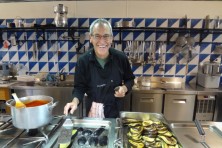Cahors, France – Malbec
- Share
- Tweet
- Pin
- Share
This week we visit one of the lesser-known and oldest wine regions in France, Cahors (pronounced Ka-urs). The Cahors wine region is located about 110 miles southeast of Bordeaux in the valley of the river Lot.
Wine production here has been continuous since the Ancient Romans planted the first vineyards over 2,000 years ago. In the Middle Ages, wine from Cahors was often called “the black wine of Lot,” which is a reference to its typical inky black color as well as the valley of origin. The wines of that time were most likely a blend of Malbec (known locally as Côt, Côt Noir or Auxerrois), Merlot and Tannat. Today the AOC (Appellation d’origine controlee or “controlled designation of origin”) certification system requires the same blend, with Malbec being a minimum of 70 percent of the total, making Cahors the only French AOC dominated by the Malbec grape.
The geography of Cahors creates conditions that are ideal for growing the warm temperature loving Malbec grape. The Lot valley winds between the 44th and 45th parallel in the southwest of France, uniquely equidistant (about 120 miles) from the Atlantic Ocean to the west, the Mediterranean Sea to the east and Pyrenees Mountains to the south. Located at the center of this triangle, the 10,000 acres of the Cahors region are protected from Atlantic humidity in the summer and typical autumn rains from the Mediterranean, allowing for full ripening of the grapes in most years. However, the valley is subject to extreme temperatures with very hot summers and often bitter-cold winters, as well. In fact, a disastrous freeze occurred in February of 1956, wiping out almost all of the ancient vines. The subsequent replanting resulted in vines that are typically no older than 60 years – young by most standards.
The majority of vineyards in Cahors are planted on sheltered terraces and the slopes of the Lot valley or on the limestone plateau above the valley called the Causse. The soils in the valley are alluvial gravel and chalky stone whereas the plateaus soils are comprised of clay and rocky limestone with high red-iron oxide content. Most vineyards are planted with about 70 percent Malbec with the rest of the plantings generally consisting of Merlot and Tannat. Vintners add Merlot for softness and Tannat for structure, allowing the wines to be consumed earlier.
A great example of Cahors wine comes from Clos La Coutale, a 150-acre estate on the Lot valley floor. The winery goes back six generations, with Valmy and Philippe Bernèd currently operating the vineyard. Their signature wine, called simply Clos La Coutale, is an oak-aged blend of 80 percent Malbec and 20 percent Merlot. We also tasted a Malbec from the Mendoza region in Argentina which is becoming more and more popular. Our tasting notes follow:
Clos La Coutale (imported by Kermit Lynch) Malbec Cahors 2009
Appearance: intense scarlet with a bit of cloudiness
Aroma: cassis, anisette, blackberry and some baking spice in the nose
Flavors: juicy beginning with some spice tones adding some black cherry
Finishing Notes: balanced with fruit flavors carrying through to the finish
The Wait XII Malbec Mendoza Argentina 2008
Appearance: garnet with an orange hue
Aroma: fresh hay, cocoa and tobacco with a bit of dark fruit
Flavors: black cherry and blackberry flavors adding red plum and raspberry toward the end
Finishing Notes: cocoa notes carry from start to finish adding a black pepper spice
Food Pairing:
– Cahors Malbec: cassoulet, game and full flavor meats like venison, pheasant and partridge, as well a lamb or rabbit; good with root vegetables and dried fruits in dishes also
– Mendoza Malbec: red meats and rib-sticking stews, also with more game style dishes
Perfect Pairing:
– Cahors Malbec: a white bean cassoulet with ham hocks, salt pork, pancetta, duck confit and lamb and pork shoulder
– Mendoza Malbec: braised shank of beef with garlic, shallots, carrots and thyme presented with a sweet potato mash
WINE:30 is written by Karl Bradley and Jody Wuollett. Karl and Jody are both long time residents of Door County and are employed at the Mission Grille in Sister Bay. They have both been awarded the first level of certification from the Court of the Master Sommeliers.
Weekly Wine Trivia
What is the only region of France that names their wines based on the varietal of the wine and not the region they are from?
Email your answer to Karl & Jody at [email protected]. The first correct answer in their inbox will receive a complimentary bottle of wine from them. Cheers!
Last week’s trivia: What is the official symbol used by the Consorzio Chianti Classico (the foundation of producers in the Chianti Classico region)?
Answer: A black rooster


